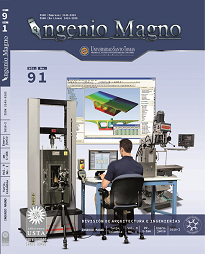Integration of algorithms knn an fp-growth to support the management of relations with clients
Main Article Content
Abstract
Downloads
Article Details
DECLARATION OF ORGINIALITY OF SUBMITTED ARTICLE
With this document, I/We certify that the article submitted for possible publication in the institutional journal INGENIO MAGNO of the Research Center Alberto Magno CIIAM of the University Santo Tomás, Tunja campus, is entirely of my(our) own writing, and is a product of my(our) direct intellectual contribution to knowledge.
All data and references to completed publications are duly identified with their respective bibliographical entries and in the citations thus highlighted. If any adjustment or correction is needed, I(we) will contact the journal authorities in advance.
Due to that stated above, I(we) declare that the entirety of the submitted material is in accordance with applicable laws regarding intellectual and industrial property, and therefore, I(we) hold myself(ourselves) responsible for any complaint related to it.
If the submitted article is published, I(we) declare that I(we) fully relinquish publishing rights of the article to the University Santo Tomás, Tunja campus. As remuneration for this relinquishment of rights, I(we) declare my(our) agreement to receive two (2) copies of the edition of the journal in which my(our) article appears.
References
Betarte, L, Machado, R y Molina, V (2006). PGMUSICA: sistema de recomendación de música basado en filltrado colaborativo. Tesis de grado. Universidad de la República. Facultad de Ingeniería. Instituto de Computación. Uruguay. Disponible en: https://www.fing.edu.uy/inco/grupos/pln/ prygrado/InformePGMusica.pdf
Brusco, M. (2011). La influencia del uso de las TICS en la Internacionalización de las PYMES. Universidad Pompeu Fabra.
Cano, J. (2007). Business Intelligence: competir con información. ESADE Business School, Universidad Ramon Lluli, España.
Cardacci, D. (2016). Refactorización de código y consideraciones sobre la complejidad ciclomática. Universidad del Cema, Buenos Aires, Argentina. Disponible en: http://www.ucema.edu.ar/publicaciones/download/documentos/592.pdf
Castañeda, J. y Rodríguez, M. (2003). La minería de datos como herramienta de marketing: Delimitación y medidas de evaluación del resultado. Gestión científica empresarial. ISBN 84-9745-051-5.
Castillo, J. y Palomino, L. (2012). Implementación de un Data Mart como una solución de Inteligencia de Negocios para el área de logística de T-Impulso. Revista de investigación de sistemas e informática, Facultad de Ingeniería de Sistemas e Informática, Universidad Nacional Mayor de San Marcos. Disponible en: http://revistasinvestigacion.unmsm.edu.pe/index.php/sistem/article/view/5713/4944
Chen, I. y Popovich, K. (2003). Understanding customer relationship management (CRM): People, process and technology. Business Process Management Journal. DOI:10.1108/14637150310496758
García, C. y Gómez, I. (2015). Algoritmos de aprendizaje KNN y KMEANS. Universidad Carlos III, Madrid. Disponible en: http://www.it.uc3m.es/jvillena/irc/practicas/08-09/06.pdf
Marcos, E. (2002). Investigación en Ingeniería del Software vs Desarrollo Software, MIFISIS. pp. 136-149.
Marina, S. (2014). Suite de algoritmos de recomendación en aplicaciones reales. Tesis de grado. Universidad Autónoma de Madrid. Departamento de ingeniería informática. Madrid. Disponible en: https://repositorio.uam.es/ handle/10486/660903
Meroño, A. (2004). Tecnologías de información y gestión del conocimiento: integración en un sistema. Revista Economía Industrial. 107-116. Disponible en: https://dialnet.unirioja.es/ revista/445/A/2004
Pinho, J. (2010). Métodos de clasificación basados en asociación aplicados a sistemas de recomendación. Departamento de informática y automática, Universidad de Salamanca. Disponible en: http://hdl.handle.net/ 10366/83342
Rosado, A. y Rico, D. (2010). Inteligencia de Negocios: Estado del arte. Scientia Et Technica. Vol XVI, núm. 44. Disponible en: http://www.redalyc.org/pdf/849/84917316060.p df
SEI (1997). Software Technology Reference. Página 147. Disponible en: https://resources.sei. cmu.edu/asset_files/Handbook/1997_002_001_16523.pdf
Virseda, F. y Román, J. (s.f). Minería de datos y aplicaciones. Universidad Carlos III.

